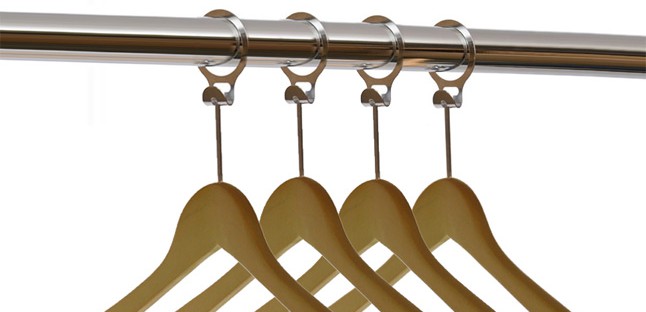Latest posts
A masterclass in creating value
What’s going on at parkrun?
Virtue-signalling all the way to the bank
Bud Light: brand purpose or virtue-signalling?
The Coddling of the American Mind, by Greg Lukianoff and Jonathan Haidt
Belonging, by Owen Eastwood
Such a simple thing
The Long Win, and The Scout Mindset
The Cult of We by Eliot Brown and Maureen Farrell
Coffee and covid modelling
By theme
Marketing strategy
Insight & metrics
Innovation & inspiration
Brand & positioning
Marketing communications
Business purpose
Leadership
By industry sector
Financial services
Retail
FMCG
Technology & start-ups
Consumer services
Business to business
Other sectors
By type
Books
Comment
Quotes
Thought leadership
I heard the great Gary Hamel, co-author of Competing for the Future, give a talk on innovation a while back, at the London Business School. He cited the classic hotel clothes or coat hanger as “stupid” – this one. Because it is infuriating to use, isn’t it?
Professor Hamel used it as an example of poor innovation – and of course he’s right, it is rubbish for the end user, the hotels’ customers, you and me. But it is ubiquitous, so there must be lots of people who think it’s a great solution. That got me thinking, a solution for whom? The customer who paid for it, of course, the hotelier. If the brief from the hotelier was, “Help us to save money, by stemming the loss of coat hangers”, then it’s a perfect response. Viewed narrowly, it’s great innovation! No one’s going to steal one of these. (Good job they didn’t take the same approach to the loss of hotel towels – one end would be tethered to a hook on the bathroom wall.) But in solving the direct customer’s problem, the designer created a problem for the customer’s customer, and that can’t be good.
So here’s a challenge: a great response to the business need, as articulated by the client, creates a bigger problem for the client that they may not even be aware of. Did anyone think to check why hangers were disappearing, and try to solve the problem another way? I can think of a couple of alternatives that might cost less and make customers happy. The Malmaison Hotels Group do this nicely with toiletries – they give generous-sized bottles which are labelled “Take me home”. You feel like you’re getting some extra value, even as you pay their super-premium room rates. Or how about an approach informed by behavioural economics? A friendly sign saying, “If you like our chunky hangers, you can buy them and take them home – just check the box on the minibar list”. That’s how hotels deter people from taking bathrobes, so why not use it here too. Maybe people would be happy to have a fiver added to their bill to make it ok to take them. It would certainly make me think twice about popping them into my case and hoping no one notices.
OK, so we don’t choose our hotel based on what sort of hangers they have, but if this is indicative of the general approach they take to improving their business, then there will be a cumulative impact on customers, not to mention the penny-pinching attitude that employees will feel and will express to customers.
The goal in business-to-business marketing must be to help the direct customer do what they do better. Innovation should be to enhance the experience of their customers, and/or their employees, so as to improve their own business performance in the long term. The best innovation saves money and enhances the experience – online order tracking, for example – but so-called innovation that focuses solely on cost reduction is risky (unless the savings are to be shared with the customer). Short term gain can be had, but it will usually at the expense of the very people that business is relying on, their own customers. Marketers can make the difference here, by thinking about how cost-saving initiatives will impact customers and employees.
Why wait to respond to cost cutting measures, though? We can be proactive: thinking through the customer journey – both the purchase journey and the usage experience – is a great way to pre-empt these cost-led initiatives which are value-reducing as well as cost-reducing. Instead you can create a true win-win in which costs are reduced, time saved, and value increased for the customer.
I’ve written, and you’ve read, a whole piece about this stupid coat hanger. Particularly in luxury categories, details matter. They help me, the customer, rationalise my expenditure. This one tiny detail – like Malmaison’s “Take me home” toiletries – can make a big difference to how customers feel. Our job as marketers is to create value for customers and thus revenue for our business. The coat hanger indicates a value extraction mind-set at work – how can the hotel spend less on its fittings while charging guests the same rate – rather than a value creation mind-set. A great marketer would see the opportunity inherent in the disappearing coat hangers: customers want them. So let them have what they want, and make it nice for them, at a price we can all feel good about, so they feel good about you. And the rest of us can have proper coat hangers in our hotel rooms.
Latest posts
A masterclass in creating value
What’s going on at parkrun?
Virtue-signalling all the way to the bank
Bud Light: brand purpose or virtue-signalling?
The Coddling of the American Mind, by Greg Lukianoff and Jonathan Haidt
Belonging, by Owen Eastwood
Such a simple thing
The Long Win, and The Scout Mindset
The Cult of We by Eliot Brown and Maureen Farrell
Coffee and covid modelling
By theme
Marketing strategy
Insight & metrics
Innovation & inspiration
Brand & positioning
Marketing communications
Business purpose
Leadership
By industry sector
Financial services
Retail
FMCG
Technology & start-ups
Consumer services
Business to business
Other sectors
By type
Books
Comment
Quotes
Thought leadership
